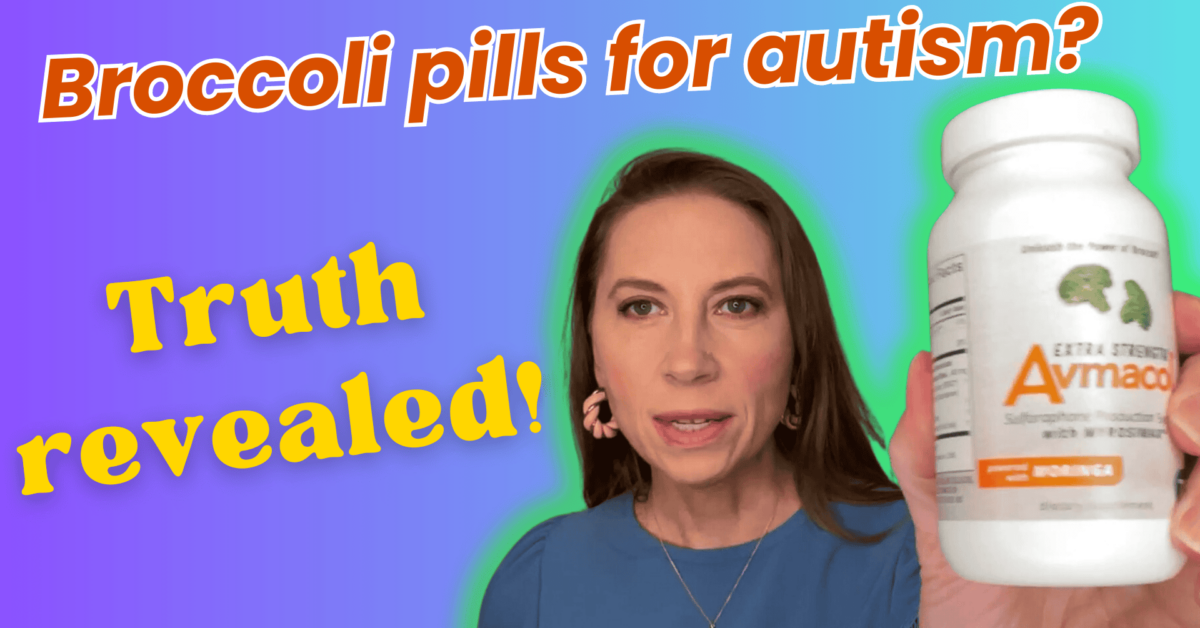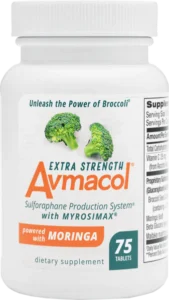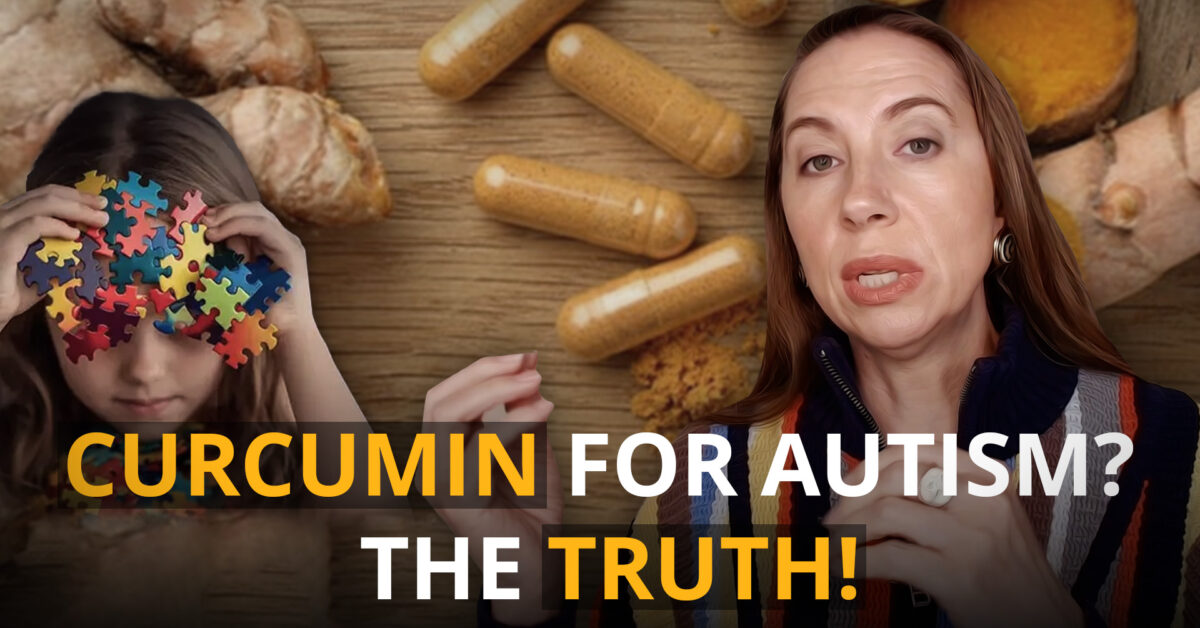What is Avamacol and why is it so popular? Why are parents turning to it to improve their child’s health?
Avamacol is a sulforaphane supplement made from broccoli seed extract and maitake mushroom. It’s increasing in popularity due to its detoxification and immune support benefits. Let’s start with the basics.
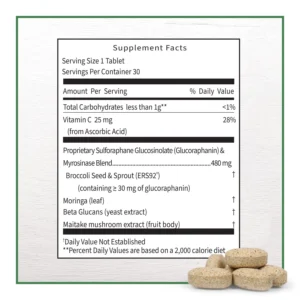
What is sulforaphane?
It’s a powerful compound found in vegetables like broccoli and broccoli sprouts known for its ability to fight oxidative stress and inflammation.
Let me simplify that. Oxidative stress happens when there’s an imbalance between harmful molecules called free radicals and the body’s ability to detoxify them.
In children with autism, research shows oxidative stress is often higher than normal, leading to inflammation, many times neuro inflammation, and it impacts how your child can develop and function.
A variety of preclinical research regarding the role of sulforaphane in neuroprotection has been conducted with very promising results. There’s only been a few human trials regarding the neuroprotective effects of sofiorafane in the nervous system. However, sulforaphane has very strong antioxidant and anti inflammatory properties which allow it to dramatically reduce cytotoxicity in the nervous system with, apparently, very little toxicity of its own. That is all great research to know and learn about.
Sulforahphane and its benefit for autistic children
How might sulforaphane, and, in particular, Avmacol, benefit autistic children? There have been several research studies exploring the effects of sulforaphane on autism.
2014 study
In 2014, there was a randomized, double-blind, placebo-controlled study involving 40 males with moderate to severe autism, and they were aged 13 to 27. Participants who received sulforaphane supplements showed significant improvement in social interaction, abnormal behaviors and verbal communication, compared to those who received a placebo.
After 18 weeks, the sulforaphane group had noticeable improvements. However, the benefits decreased when the treatment was stopped. That’s not really good news.
In 2017, there was a follow up study re-examining the original participants from that 2014 study (those are great young men and great parents to continue this observation). The researchers wanted to observe the long term effects of sulforaphane. What they found was that the improvement in behavior and communication observed during that initial study when the people were taking sulforaphane, it was not present when participants stopped taking sulforaphane.
This emphasized the need for continuous use of sulforaphane to maintain positive effects. However, if you know me, you know I do not like that. I do not want to be dependent upon anything and I don’t want anyone to have to be dependent on taking a pill every day in order to see that continuous improvement.
It’s always important to get to what is the root cause for this inflammation. There’s always a root cause. You’ve got to always find the root cause if sustained improvement is really what you want.
2023 study
Now, here’s an interesting clinical trial that was done on sulforaphane. 2023 – randomized, double-blind, placebo-controlled study with those with autism, aged much younger – three to seven years old. Duration was 36 weeks long. They were given sulforaphane and the researchers concluded that there was no measurable change whatsoever.
Mixed results
Now, confusing, right? Sulforaphane showed positive results in one clinical trial, but then nothing in another. So what do you do? Did it work? Did it not? Is it good? Is it not?
I think you know me by now – I am going to go deep into the research and say, “I need to understand that”. I took time to read each publication and to look at what the researchers did. I used to work on clinical trial design when I was a medical strategist for the pharmaceutical industry. So I have some familiarity about clinical trial design.
So when I went into the details, I found that the dosing is different. The study in 2014, which actually showed results, had a dosing of 50 to 150 micromoles, whereas the 2023 clinical trial had a dosing of a maximum of 50 micromoles.
You can see, that’s a difference, and it actually matters. If you do some chemistry conversions, 50-150 micromoles actually equals 8-26 mg of dosing per day. I tell you milligrams because that’s what gets listed on different bottles, so I want you to know the dosing that was used in the clinical trial and you can compare it to a label of a supplement maybe you’re considering.
Benefits
Studies show that sulforaphane can improve key symptoms like irritability, hyperactivity, and social interaction. One study even found improvement in social responsiveness in children with autism after just 12 weeks of sulforaphane supplementation.
How to use sulforaphane
Please keep in mind, timeframe. We’re talking 12 weeks, 18 weeks. These are long term. You’re not going to see overnight results with sulforaphane. This is something that builds and builds and builds. So if you were to start a sulforaphane supplement, 12 weeks would be the absolute minimum that I would use it before I started making the conclusion as to whether it was working or not.
And please keep in mind dosage. You will likely need a higher dose if you haven’t addressed the root cause. So let’s say your child is currently being exposed to mold every day. You would probably need a higher dose than when you resolve the mold and he’s not being reintroduced. So always keep in mind dosing and the environment.
Avmacol
How does Avmacol compare to other sulforaphane supplements? I should probably point out that Avmacol is a sulforaphane supplement and this is why it’s popular with parents and also doctors. So what makes Avmacol different from other sulforaphane supplements?
Avmacol actually is the sulforaphane brand that’s most used in clinical trials, and that’s also why many doctors recommend this specific brand.
Risks or controversy around Avmacol
There have been several clinical trials done researching if sulforaphane can impact any autism behaviors. The results have been mixed. We talked about the reason why – the clinical trials used different dosing. So that would be a kind of the controversy, does it work? does it not work? You might have heard someone say that, “oh yeah, it is working”. You’ve got to know dosing and time. There’s always details.
How much Avmacol to take
If you decide to take Avmacol or sulforaphane, how do you incorporate it into your child’s routine? Typically for Avmacol extra strength (this product is the extra strength. They have a regular strength and an extra strength), it’s one tablet a day. You can choose whether morning or night.
Although I must tell you that I have seen functional medicine doctors, really good functional medicine doctors go as high as six tablets a day. Again, it really depends on your child and their unique circumstances.
Now, I understand we all want our children to be healthy and get there as fast as possible, but you’ve really got to give this enough time to come to a conclusion. So, there is a minimum of 12 weeks to see a change and then always ask yourself, am I giving a dose that would actually make a difference?
Look and taste
Let me open this up and show you what the tablet looks like.
Classic tablet. Size-wise, it’s not that large. It’s certainly manageable to swallow it. However, if you have a young child who doesn’t swallow pills, you can crush it up.
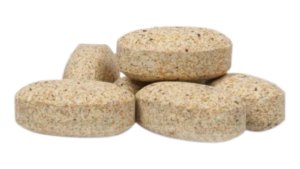
I don’t know what it tastes like. I’ll taste it for you.
It kind of tastes like broccoli. It tastes like broccoli so it’s not bad but there’s nothing sweet there.
How to take Avmacol
I would probably try and hide that in something like around dinner time. You could crush it up, mix it in the first bite of dinner, whatever that is. Or what you could do is put it in smoothies and things like that. But sometimes smoothies are not right for certain children.
I would definitely hide it in food. I think it’s totally doable because it tastes like food. It just tastes like vegetables. I know some kids don’t like vegetables but you could hide that in like a meat flavor. You could hide that in a lot of different things.
Opt or drop
Avmacol is definitely an opt, but only if you have done lab tests that show you your child is having issues with like inflammation, the gut, or mitochondria. You can measure any change and make sure that it is actually having an impact on your child. And certainly look at the two different strengths.
But this is definitely an opt.
